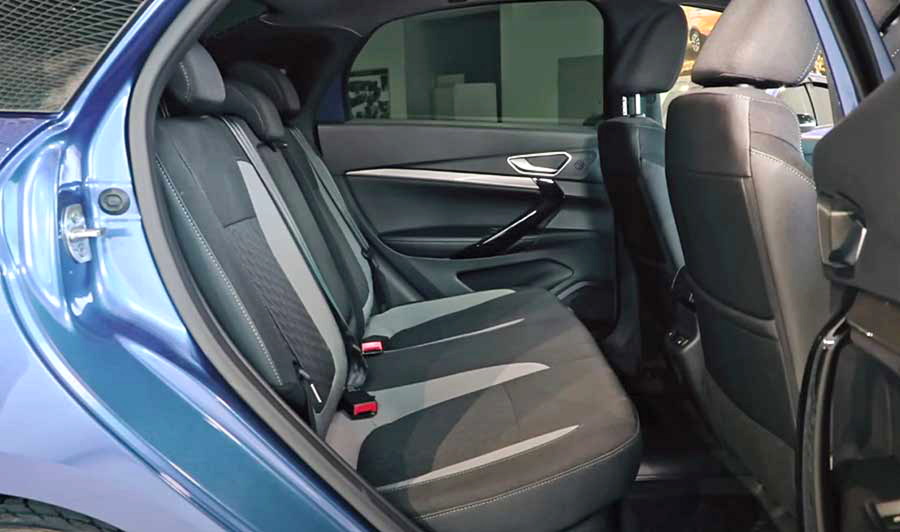Lada Vesta 2022 new body, prices, equipment, photo, video test drive
Material content
All details about the facelift
Lada Vesta in the past 2021 turned out to be the most popular car in Russia, it was sold in the amount of 113.7 thousand units, and in 2022 the record will obviously be broken, as the updated version comes out. Yes, Vesta was not much ahead of Granta (111.4 thousand sold cars), but left all the other contenders far (Kia Rio – 82.9 thousand, Hyundai Creta – 68.08 thousand, Hyundai Solaris – 61.06 thousand). )
And this only increases interest in the Lada Vesta 2022 model year, which will appear in car dealerships in March, besides, it is promised a serious modernization, which will affect, first of all, the interior equipment. Judging by the already registered patents, it will be seriously updated.
Video
Technical stuffing and characteristics
No technical innovations are planned, so the Lada Vesta FL 2022 will be offered with the same engines. Accordingly, the 16-valve VAZ-21129 with a working volume of 1.6 liters will remain the basic option, producing 106 horsepower (at 5800 rpm) and 148 Nm of torque (at 4200 rpm).
Working in conjunction with a mechanical “box”, he is able to accelerate the car to 100 km / h in 11.8 seconds, and with the “robot” it will take him 1 second more. The average “passport” fuel consumption for this engine is 6.6-6.9 liters, “maximum speed” – 178 km / h.
The second unit is also a 1.6-liter, but “imported”, developed by Renault-Nissan specialists. Its capabilities are 113-114 “horses” at 6000 rpm. and 153 Nm of thrust at 4400 rpm. Also, VAZ 1.8 engines (122 hp) and their forced versions with a capacity of 145 hp will remain in service. s., which, apparently, will go not only to the Vesta FL Sport versions, but also to the Vesta FL SW Sport station wagons.
Lada Vesta NG can get an automatic gearbox with two clutches or a new CVT
In 2023, Vesta NG may receive unscheduled technical updates. First of all, it concerns the transmission. AvtoVAZ previously refused to install the AMT robotic transmission on Vesta (however, its production is currently impossible in any case, since the latter contains components from the ZF company that left Russia). The Jatco JF015E variator will no longer be available either. It was purchased by the former co-owner of AvtoVAZ, the Renault-Nissan concern. At the same time, Veste’s automatic transmission is essential. For example, the largest taxi and car sharing aggregator Yandex is interested in buying a large batch of cars for its needs, but, of course, with a gun. Yes, and private owners are not eager to buy a novelty on the mechanics, because the car is far from being a state employee.
As an alternative, the purchase of automatic transmissions in China is being considered.. It can be either a CVT or a robotic box with two wet clutches. The first option is cheaper, but poorly suited for harsh operating conditions in the regions and less maintainable. The second one is more expensive, but the price of such an automatic transmission approaches that of a classic automatic transmission with a torque converter. Many will probably ask: why not choose a classic 6-speed automatic? The thing is that such transmissions are mostly produced in China under license, which means that in the case of cooperation with AvtoVAZ, their manufacturers risk falling under secondary sanctions. Another reason is layout. It is difficult to fit a modern 6-speed automatic in the engine compartment of a car, since its placement there was not provided for at the design stage of the car.
At the moment, the decision on the machine gun for Vesta has not yet been made, which means most likely, in March 2023 we will see only a version with mechanics. The transmission will have to wait.
Advantages and disadvantages
To find out whether the Russian model in the current version deserves attention or it is better to take a closer look at its “classmates”, the main advantages of the car should be highlighted:
- the most affordable price in the class;
- cheap maintenance and repair;
- use of AI-92 gasoline;
- compliance with the Euro-5 environmental standard;
- good ground clearance for a car;
- a variety of configurations;
- good technical equipment.
This car was not without some shortcomings. In particular, the car is distinguished by mediocre dynamics, not the best safety in comparison with many “classmates”.

What changed
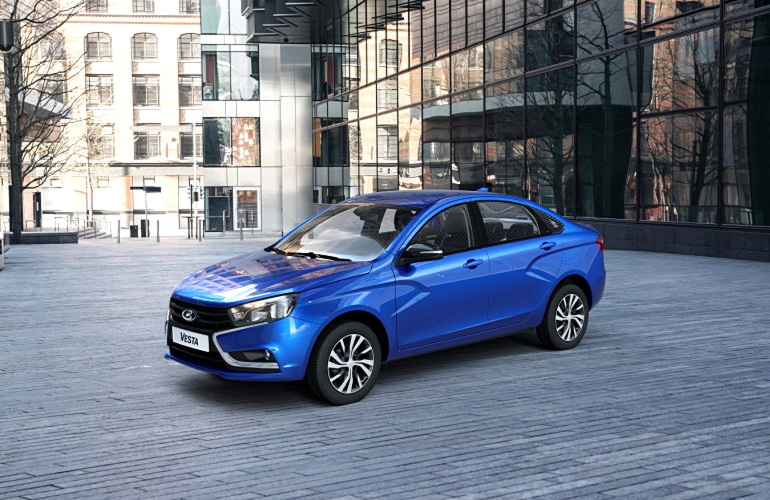
The most striking innovation, immediately noticeable in the photo of Lada Vesta, is the relief shape of the front bumper with a built-in chrome arc and narrowed headlights – these innovations made the overall image of the car more rapid. Previously, additional inserts in other variations of Vesta were not used.
The headlights are fully LED, including taillights and foglights. Incandescent lamps remained only in the rear turn signals. The new headlights shine noticeably better: the dipped beam has become further by 10% and wider by 30%, and the tunnel effect has been removed from the main beam. New headlights are already sold separately as a spare part for 25 thousand rubles. They will not fit on other versions of Vesta: in order to install them, you will have to change the bumper as well.
In different modifications of the new Vesta, the design of the radiator grille will be different. The manufacturer offers several options. In Standard versions, the grille is crossed by two chrome moldings. They visually expand and lower the car. The cross version will receive a large-mesh grille. Two new stampings will appear on the trunk lid, which outwardly stretch the car. For Vesta, 16 and 17-inch black wheels are now available, glossy with diamond polishing.
The windshield heating system has been improved – the coverage area has been increased to capture the lower corners. There was a control of blind spots in motion and a safe parking system. Additional sensors are installed in the front and rear bumpers. The regular key has changed to a flat key card, like Renault. The keyless entry system works, a separate unlocking of the tailgate, remote engine start.
The seal under the hood has become longer and without a gap in the center, as in previous versions.
At the rear are chrome-plated exhaust pipes – this is a dummy, a design element. The real pipe and muffler are displayed on the left side and hidden from view – they are invisible from any angle, even from the level of the bumper. The towing eye is now removable and attaches to the rear beam with a threaded nut. The attachment point is neatly hidden behind a decorative cover. There is no saber on the tailgate to illuminate the license plate, and the letters LADA have become larger.
Together with the updated Vesta, a new color was introduced – dark golden “garfield”. The line will be equipped with a black ceiling, which is harmoniously complemented by a black lower trim and tinted rear window.
Are the units old?
Related materials 
If you were waiting or, on the contrary, were afraid that a brand new 1.3 TCe turbo engine would be installed on Vesta, I hasten to disappoint and please you at the same time. Fundamental changes in hardware are not expected.
The native VAZ engine 1.6 (106 hp) with a five-speed gearbox remained the base. Shestistupka — it is difficult and expensive. Not in this life.
The Renault-Nissan 1.6 engine (113 hp), which is being assembled in Tolyatti, will continue to work only in tandem with a CVT. By the way, in the ranking of the entire Renault group, our engine production occupies a very high place – both in terms of the quality of metal processing (blocks, heads, crankshafts), and in terms of assembly quality.
Related materials 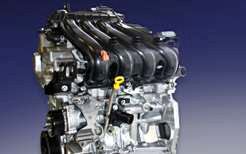
But the 1.8 engine (122 hp and 145 hp in Sport), which is still paired with only five-speed mechanics, has been upgraded. In particular, I was assured that the maslozhor won – and not just one, but a whole range of solutions. If that’s really the case, great. As soon as we get a chance, we’ll check it out.
In general, the factory workers claim that a car with a 1.8 engine drives differently – first of all, the Cross version, which now has a Lada Ride Select drive mode switch – like on the Xrey Cross. With sport mode. But more important is that now Vesta Cross has the function of electronic simulation of differential lock EDL – it means that in difficult conditions it will row with two wheels at once, and this is a serious help both on impassable roads and on snow.
 I have not been to the plant in Izhevsk for several years, and during this time a lot has changed here. In particular, on the body welding line. For example, if earlier the roof was installed manually into the conductor, now it is done by a robot. This and many other solutions pursued very specific goals: to improve the geometry of the body and align the gaps on the outer panels. And on the anti-corrosion waxing line, the body cavities are also processed by robots.I have not been to the plant in Izhevsk for several years, and during this time a lot has changed here. In particular, on the body welding line. For example, if earlier the roof was installed manually into the conductor, now it is done by a robot. This and many other solutions pursued very specific goals: to improve the geometry of the body and align the gaps on the outer panels. And on the anti-corrosion waxing line, the body cavities are also processed by robots.
I have not been to the plant in Izhevsk for several years, and during this time a lot has changed here. In particular, on the body welding line. For example, if earlier the roof was installed manually into the conductor, now it is done by a robot. This and many other solutions pursued very specific goals: to improve the geometry of the body and align the gaps on the outer panels. And on the anti-corrosion waxing line, the body cavities are also processed by robots.I have not been to the plant in Izhevsk for several years, and during this time a lot has changed here. In particular, on the body welding line. For example, if earlier the roof was installed manually into the conductor, now it is done by a robot. This and many other solutions pursued very specific goals: to improve the geometry of the body and align the gaps on the outer panels. And on the anti-corrosion waxing line, the body cavities are also processed by robots.
Interior changes
One of the most important innovations of Vesta is the availability of keyless entry, and now the outdated ignition key with a flip “sting” has been replaced with a modern key fob with buttons and the Lada logo, which, by the way, also remotely starts the engine.
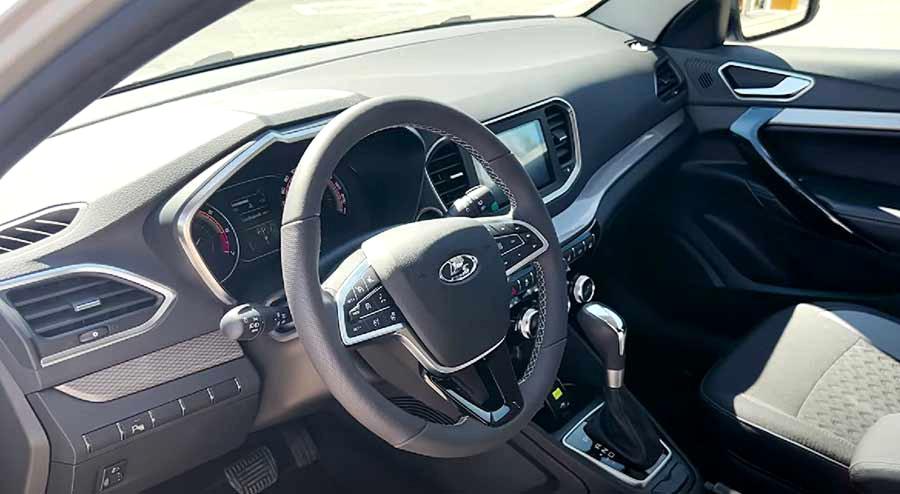
When approaching a car with such a device, the door locks are automatically unlocked, and when moving away from the car, they again close (the “Hands Free” function).
And if in the external appearance of Vesta all the innovations are not so striking, then in the interior they immediately make you pay attention.
Changes in the Vesta interior compared to the pre-styling version:
- instead of hard budget plastic, a softer structural material with a pleasant to the touch surface was used in the dashboard case, and a decorative silver strip stretches across the entire width of the dashboard, except for the driver’s side;
- door cards became more attractive, having received soft eco-leather armrests, black shiny handrails, decorative inserts;
- the ESP block acquired keys of a different format with smooth switching, the “auto” function was added to the front windows;
- on the steering wheel with a silver trim and a small black glossy overlay, the controls are placed differently, while the key that changes the settings of the on-board computer is no longer located on the right steering column switch, but directly on the steering wheel;
- as standard, a combination of instruments with analog tachometer and speedometer wells is provided, in the top version, a digital panel becomes available;
- a completely different air conditioning control unit was used (the same as on the Renault Arkana / Duster) – with three large rotary “washers”, standard flat and lever-shaped buttons, but climate control, even at “maximum speed”, is only single-zone;
- a round Start-Stop button is installed to the right of the steering wheel, and now with its help the engine starts, the only prerequisite is that the key card is located within the passenger compartment (you still need to press the brake pedal);
- another front ceiling lamp was used – it is rectangular in shape, with LED lamps and an originally designed eyeglass case;
- the seat heating buttons, which used to be behind the gearshift lever, have moved higher to the center console, but the plugs have been left in their original place:
- the upholstery of the ceiling is presented in black, and its material is of better quality, although it is difficult to say what it will be in the basic configuration;
- the heating of the windshield has been improved, that is, its area of \u200b\u200boperation has been expanded.
The two front cup holders are still located close to the climate node, but in front of them the platform has increased, on which you can now place a smartphone.
Above, there are two USB connectors: one for data transfer, the other for charging gadgets, between them there is a 12-volt outlet.
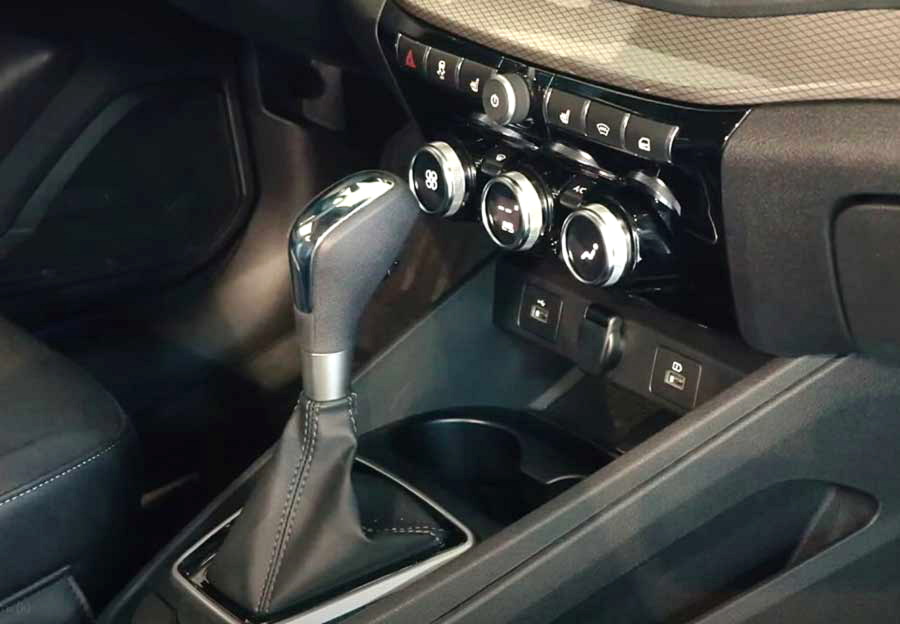
In the middle configuration, multimedia is provided with a 7-inch display; in more expensive versions, AvtoVAZ will offer a remote-type multimedia screen in the form of a tablet, mounted vertically on the instrument panel.
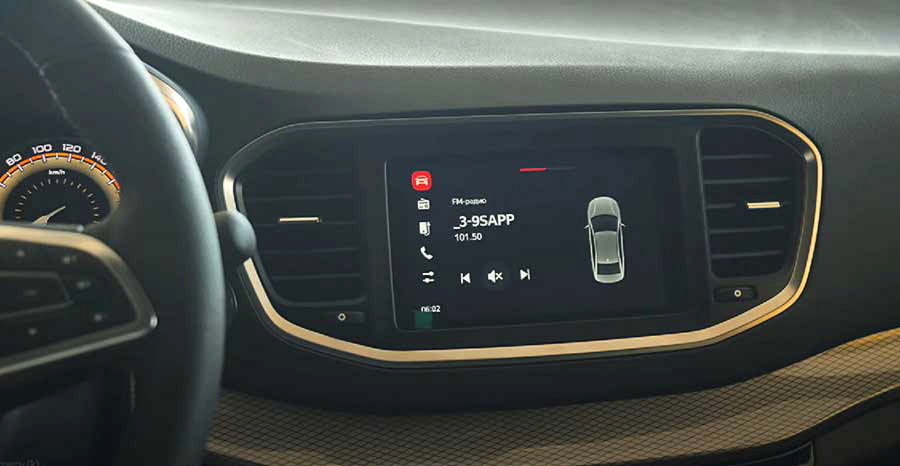
The seats in the cabin remained unchanged, and the modernization did not touch the front center armrest with its box.
There is virtually nothing new on the second passenger row, unless you take into account the modified interior door skins.
